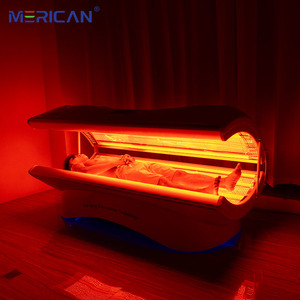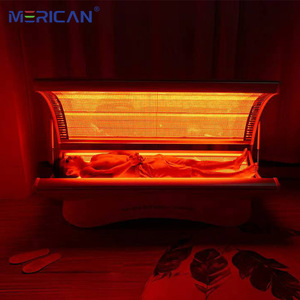(22588 products available)
















































 Ready to Ship
Ready to Ship

























































































































































































Red light sources usually come in various types and categories in beauty and health. For customers who intend to stock up on these products, knowing their differences, how they work, and their effects will help one to buy and encourage one to recommend to relatives, friends, and anyone who needs them.
The following are the main types of red light source used in beauty and health.
LEDs have become one of the most common light sources because they are energy-saving and have a long lifespan. When used for beauty and health, they emit light at specific wavelengths, including red. The red light penetrates the skin deeply and stimulates healing, collagen production, and cell regeneration. Hence, businesses selling skin care products and equipment should stock red LED lights because their longevity and efficiency will make it easy for them to sell. The red LED lights can also serve as beauty treatment devices, which businesses in this niche can sell as part of their beauty clinic.
Laser sources are often used in skin treatment and analysis. For instance, dermatologists use lasers to treat skin problems such as wrinkles, acne scars, sun damage, and hyperpigmentation. Beauty and health professionals should also consider red laser light as a source because consumers wanting more professional tools will be interested in this type of beauty and skin treatment technology. Applier of this source must be qualified personnel, as the damage caused by unqualified people using this source is significant. Clinics that want to treat their clients using laser sources will order them in bulk for their clinics' effectiveness, quality, and safety, and these tools will treat beauty and skin problems that interfere with a person's self-esteem.
Many therapy devices are available with red light that treats various body pains, improves healing, and eases muscle problems. These devices are often used in rehabilitation settings. Commercial entities in the wholesale segment in health care who wish to supply rehabilitation equipment and tools to their clients can consider stocking these kinds of items. These apparatus will be utilized in rehabilitation clinics, sports centers, and other institutions where people go to heal from injuries or sicknesses caused by physical activities. The sources of red light are large and are used for healing and recovery. Grouping them makes sense and offering them to beauty and health businesses that need items that require healing and recovery.
Some devices use infrared and red light. They treat different skin and body parts simultaneously. These devices are in high demand as they help clinics and salons to offer more treatment in one device. This is especially great for beauty treatments where different light wavelengths can tackle various skin issues. For businesses that want to sell aesthetic treatments to their customers, stocking these combination devices will help them because they work on so many beauty problems simultaneously.
How long a red light source will last is critical when deciding what source a business will stock or what beauty treatment it will use in its clinic. The durability depends on the materials used to manufacture the light source and the technology behind it, so understanding what makes the device durable or not helps one choose the most appropriate device in terms of quality and price.
LED lights can last from 30,000 to 50,000 hours. Most home and professional devices use LEDs as they have the longest lifespan. The technology used ensures continuous light without the need for constant replacement. It is also very energy efficient. Users can enjoy long, uninterrupted treatments, making it perfect for clinics that need to treat many clients. Low operational costs for themselves or the businesses using them because they use less energy and do not require frequent replacements.
Lasers are quite durable; they can last anywhere from 20,000 to 30,000 hours, depending on the laser type and how it is maintained. These sources have a longer lifespan than traditional lasers but are still longer than most light sources in the market. Laser technology is very precise, and after many uses, it will still maintain its accuracy and effectiveness. This is especially relevant for medical and cosmetic treatments where exacting consistency over time is vital.
As for the materials, most red light devices' cases and housing are made of plastic and aluminum. However, there are steel devices that are very strong for environments where they will be used a lot. Plastic is commonly used because it is light and relatively inexpensive; however, it can be less durable if exposed to harsh conditions. Aluminum and steel are more robust and weather-resistant, suitable for rehab or clinical use.
Red light sources are in numerous fields, but they are mainly in beauty, health, and commercial usage. Businesses should understand how their customers use the devices so that they can stock products that will fulfill their customers' needs and ensure that they help their clients achieve their desired results.
Clinics and salons use red light to treat wrinkles, fine lines, and other signs of aging to stimulate collagen and elastin to promote skin cell renewal. This deep penetration into the skin helps to keep the skin firm and youthful. Different devices are available to offer this treatment, from home-use to professional strength. Commercial users and wholesalers should consider stocking these items so that clinics can get all they need in one place.
Health facilities such as hospitals and clinics are always looking to improve their wound healing treatments. They use red light in laser or LED form to speed healing, reduce scars, and minimize pain and infection time. Large rehab facilities all use the same thing, and it breaks up the lines so that one vendor serves them all.
In beauty treatments, clinics and salons use red light to stimulate hair follicles to promote hair growth and prevent hair loss. This is especially good for people with thinning hair or on the verge of losing it. Many styling devices have this technology to help salons and stylists treat their clients while still offering core beauty services.
Red light sources are used in physical therapy and chiropractic treatments to relieve pain and inflammation for joint pain, muscle soreness, and chronic conditions. This therapy saves pain for patients undergoing recovery and allows them to heal faster without the usual pain that comes with injuries.
In fitness centers, athletes use red light to help them recover from workouts faster, ease muscle soreness, and even prepare their muscles for intense workouts. Many new workouts use red light to help users meet their fitness goals faster and with less injury.
When health and beauty professionals research wholesale red lights, they will want to ensure they stock high-quality sources that give their clients the most benefit. To do this, one must consider several factors to ensure that the source they use or buy is the right one to give the desired results with health and beauty.
This is the most important factor, penetrating the skin to stimulate cells. For skin treatments, 600 to 650 nm is best for collagen stimulation and skin renewal. For healing, hair growth, and muscle recovery, 650 to 750 nm is better for deeper tissue penetration. It is advisable to stock devices that have both so that one product can serve more purposes.
The treatment will only be effective iflight intensity and dosage are combined appropriately. Clinicians prefer variable intensity devices so they can adjust treatment depending on the condition of the patient/s. Low-intensity devices are better for home use. High-intensity professional devices are better for clients who want faster results.
How easy it is for the operator to use the device is another factor to consider. Devices with long cords are easy to move around, and their heads are adjustable to target different areas. The head size will determine how long it will take to treat a certain area. Larger heads are ideal for bigger areas, while smaller ones are for treating smaller areas.
Stocking only the best products will cut the number of returns and complaints that a business will have. Check the reviews, quality certificates, and warranties to determine how strong a product is. Make sure the sources have been tested for safety. To ease the customer's mind even more, the business should place safety warnings on items that could harm customers if misused.
Clinics and salons rely on powerful, durable machines that can withstand frequent use, so they stock commercial devices. For customers doing self-care at home, the devices must be user-friendly, cheap, and convenient to use, so they stock home-use devices.
A1: Yes, these devices are beneficial to everybody and are usually in demand because they handle so many issues related to health and beauty.
A2: The lights stimulate mitochondria, the cells' powerhouses. They boost cell activity, promoting healing, rejuvenation, and growth, helping various health and beauty problems.
A3: Commercial sources are stronger, have larger treatment areas, and can withstand long use. Home-use sources are more practical and user-friendly.
A4: Yes, it enhances results and increases blood flow and cell activity, improving how well other treatments like creams, facial masks, and topical treatments work.
A5: It is important to stock devices with eye protection, safety wires, and proper guidelines because the devices could harm the eyes or damage the skin if misused.